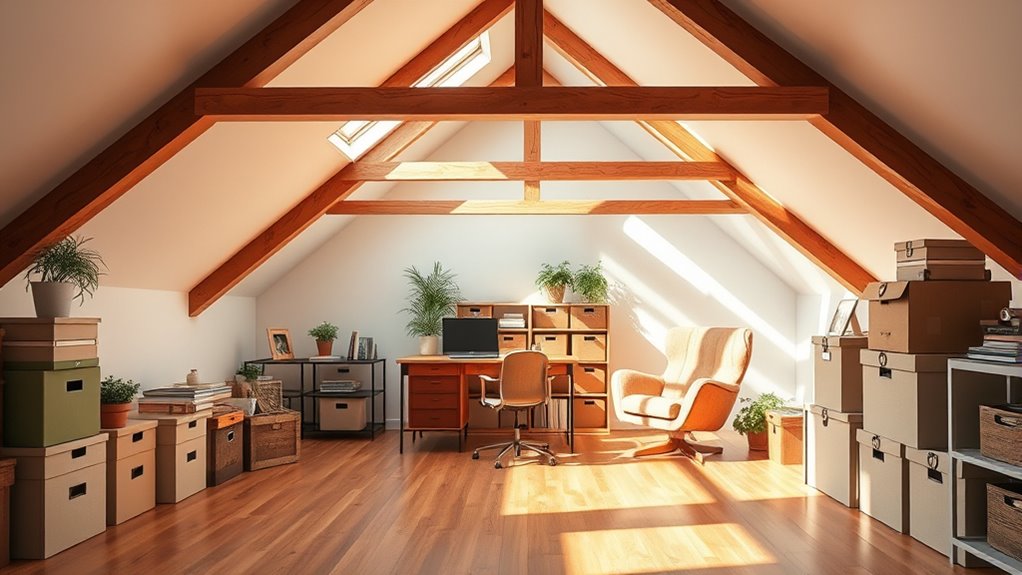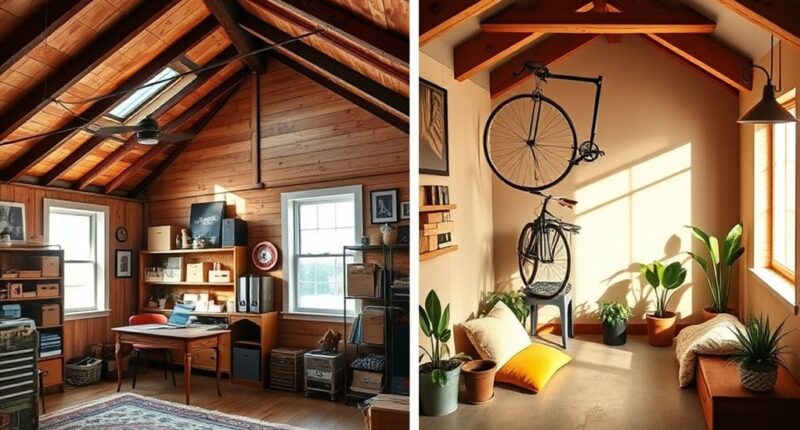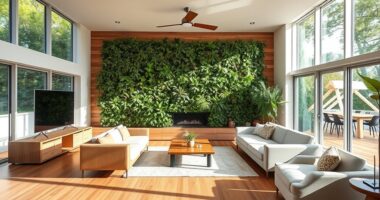Transforming unused spaces like attics, garages, and lofts open the hidden potential within your home. Picture turning an attic into a cozy retreat or an art studio, a garage into a stylish workshop, or a loft into an inviting bedroom or reading nook. With thoughtful design—adding insulation, lighting, and storage—you can create personalized, functional areas that reflect your style. Keep exploring how to turn neglected corners into vibrant, valuable spaces that truly feel like home.
Key Takeaways
- Assess structural safety and clear debris before transforming attics, garages, or lofts into functional spaces.
- Incorporate proper insulation, lighting, and flooring to enhance comfort and usability.
- Optimize space with vertical storage, zoning, and stylish organization solutions for multifunctional rooms.
- Ensure compliance with local building codes and permits for legal safety in conversions.
- Use design elements like warm tones, natural light, and layered lighting to create inviting, personalized environments.

When neglected corners and vacant rooms sit quietly unused, they hold untapped potential waiting to be realized. Your attic, garage, or loft isn’t just empty space; it’s a canvas eager for transformation. Imagine peeling back the layers of dust and clutter to reveal a room that breathes new life into your home. This isn’t merely about storage; it’s about creating an extension of your living space, a place where your personality and purpose can flourish. Every beam, every square foot whispers possibilities, waiting for your touch to turn them into something extraordinary.
Picture your attic as more than just a dusty crawl space. With a little vision, it becomes a cozy retreat, a quiet office, or an art studio. To start, clear out the debris and assess the structural integrity. Once you’ve exposed the bones of the space, you can think about insulation, lighting, and flooring. Soft, warm tones on the walls can transform a stark attic into an inviting sanctuary. Skylights or dormer windows bring in natural light, making the space feel open and vibrant. Placing a comfortable desk, plush seating, or storage solutions that double as decor can make this forgotten zone feel intentional and alive. It’s about balancing functionality with beauty, so every element enhances the ambiance. Additionally, understanding local regulations and zoning laws can help ensure your renovation complies with community standards.
Your garage, often seen as a utilitarian dump zone, holds even more potential. It’s a blank slate waiting for order and style. Clear out the clutter—tools, old boxes, and unused equipment—and consider zoning the space. Dedicate areas for a workshop, a craft corner, or even a home gym. Upgrade the flooring with polished concrete or sleek tiles, and add storage with stylish shelving or cabinets that hide the chaos behind clean lines. Bright, layered lighting can erase the garage’s usual dimness, inviting you in for projects or relaxation alike. Think about how you can incorporate cozy seating or a mini-bar to turn your garage into a social hub. The key is to blend practicality with aesthetic appeal, transforming an overlooked space into an extension of your lifestyle.
Lofts, often tucked away above the main living areas, are like secret rooms waiting to be opened. They can become intimate bedrooms, reading nooks, or creative studios. To open this potential, focus on maximizing vertical space—install shelving or hanging storage to keep things organized. Use rugs, curtains, and lighting to craft an inviting atmosphere that feels separate from the rest of your home. If you’re feeling adventurous, add a small kitchenette or a cozy seating area to make your loft a true retreat. The charm lies in its versatility; it’s a chance to craft a space that reflects your dreams, whether that’s quiet solitude or lively gatherings. Exploring building codes and permits beforehand can help prevent legal issues down the line, ensuring your project remains compliant. With a little effort and imagination, you can turn these overlooked areas into the heart of your home’s new chapter.
Frequently Asked Questions
What Permits Are Required for Converting Attics and Garages?
You’ll need permits from your local building authority before transforming your attic or garage. Start by submitting detailed plans that showcase electrical, plumbing, and structural updates. They’ll review for safety and compliance with zoning laws. Don’t forget to check if specific permits are needed for insulation or HVAC changes. Securing these permits guarantees your project is legal, safe, and ready to become a beautiful, functional space that elevates your home’s charm and value.
How Much Does a Typical Conversion Project Cost?
A typical conversion project costs between $20,000 and $50,000, depending on size, finishes, and structural changes. You’ll spend on insulation, flooring, lighting, and perhaps new windows or staircases. Custom touches like built-in shelving or skylights can elevate your space, but they add to the budget. To get an accurate estimate, consider consulting professionals who can tailor the project to your aesthetic desires and functional needs.
What Are the Best Insulation Options for Attics and Lofts?
Ever wonder how to keep your attic cozy and energy-efficient? You should consider spray foam insulation for superior air sealing and moisture control, or opt for fiberglass batts for affordability and ease of installation. Mineral wool offers excellent fire resistance and soundproofing, making it a versatile choice. Which option best suits your style and needs? Whichever you choose, proper insulation transforms your space into a warm, inviting retreat.
How Can I Maximize Storage in a Converted Space?
You can maximize storage by installing built-in shelves and custom cabinetry that fit seamlessly into nooks and crannies. Use stackable bins and under-eave drawers to utilize every inch efficiently. Incorporate multi-functional furniture like ottomans with hidden compartments or fold-away desks. Add hanging racks for seasonal items and hooks for tools. Keep it organized with labeled containers, ensuring your space remains functional while reflecting your aesthetic touch.
What Are Common Structural Modifications Needed for Conversions?
When you transform a space, expect your home’s bones to need a superhero’s touch—think steel beams for extra strength, reinforced floors to handle new furniture, and possibly adding windows for sunlight that feels like a warm hug. You might also need to reroute electrical wiring and upgrade insulation, turning your once-forgotten nook into a stunning, sturdy sanctuary. These modifications are your secret weapons for a safe, beautiful conversion.
Conclusion
Turning your attic, garage, or loft into something new is like revealing a hidden treasure chest in your home’s quiet corners. With a dash of imagination, those dusty spaces transform into cozy retreats, art studios, or guest rooms, echoing the promise of endless possibilities. Just as a painter sees potential in a blank canvas, you’ll find beauty in these forgotten nooks—waiting to be reborn into your personal masterpiece. Your home’s next chapter begins with a simple, inspired step.









